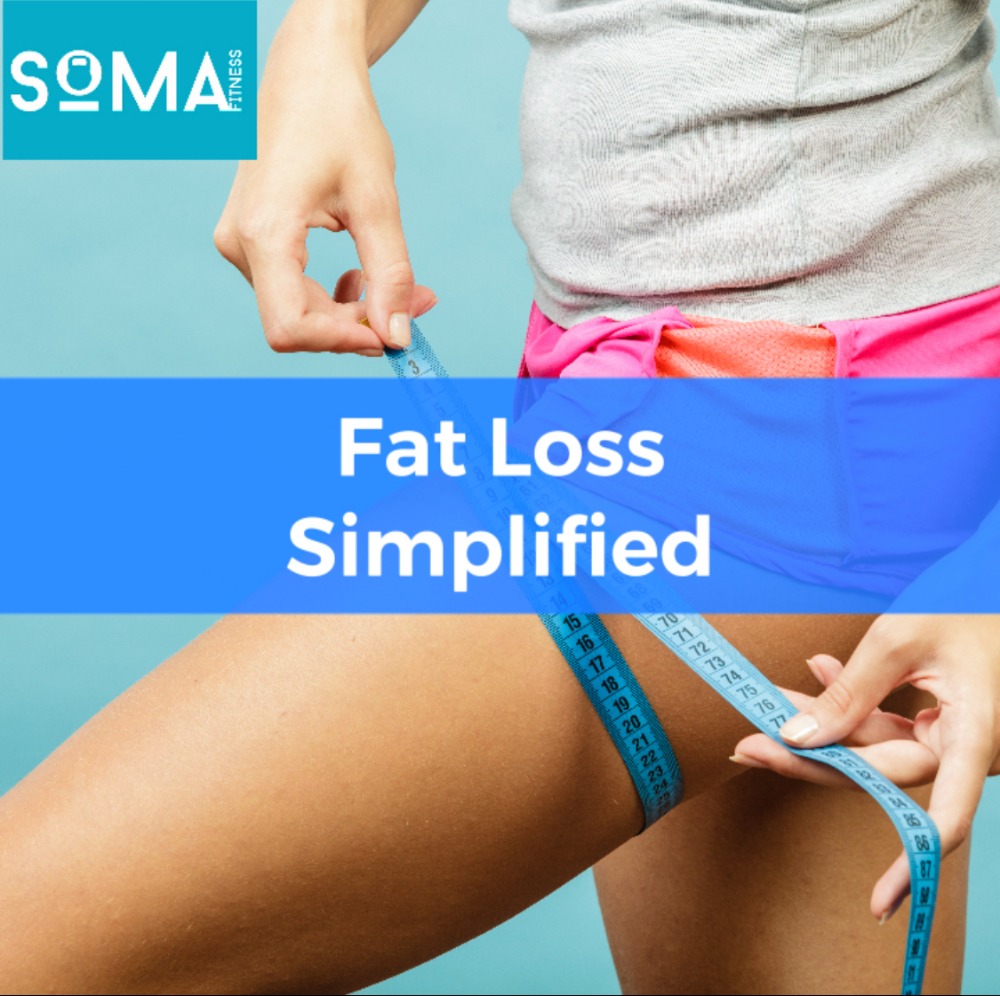Fat Loss Simplified

Fat loss is the process of losing body fat in order to become leaner and healthier. To understand how fat loss works, it’s important to know a little bit about how the body stores and uses energy.
The food we eat is broken down into various nutrients, including carbohydrates, fats, and proteins. These nutrients are then used by the body for energy, growth, and repair.
When we eat more food than our body needs for energy, the excess energy is stored as fat. This fat can be stored anywhere in the body, but is typically found around the belly, hips, and thighs.
To lose fat, we need to create a calorie deficit, which means consuming fewer calories than our body needs for energy. This forces the body to use its stored fat for energy, resulting in fat loss.
One way to create a calorie deficit is by reducing the amount of food we eat, either by cutting back on portion sizes or choosing lower calorie foods. This can be easily tracked using a calorie tracker like MyFitnessPal. Another way is to increase our level of physical activity, which burns more calories and can help create a calorie deficit.
The main habits simplified of a Fat Loss Protocol that Yields 80% of Desired Results:
- Calorie Deficit: As mentioned earlier, the most important aspect of fat loss is creating a calorie deficit. This can be achieved by reducing your calorie intake, increasing your physical activity, or a combination of both. An approximate calorie deficit of 500 calories per day is recommended for healthy and sustainable weight loss.
- Strength Training: Strength training is an effective way to preserve muscle mass while losing body fat. It also helps to increase your metabolism, which means you burn more calories at rest. Aim to do strength training exercises at least twice a week.
- High-Intensity Interval Training (HIIT): HIIT is a type of cardio that involves short bursts of intense exercise followed by periods of rest. It has been shown to be more effective at burning fat than steady-state cardio. Aim to do HIIT exercises at least once a week.
- NEAT: Non Exercise Activity Thermogenesis – is a type of physical activity that is distinct from exercise and is considered to be a significant contributor to overall energy expenditure. Examples of NEAT activities include taking the stairs instead of the elevator, standing at your desk instead of sitting, or simply moving around more throughout the day. NEAT can have a significant impact on overall health and fitness, as it can help to increase energy expenditure, improve cardiovascular health.
- Protein Intake: Protein is essential for building and maintaining muscle mass. It also helps to keep you full, which can prevent overeating. Aim to consume at least 0.8-1 gram of protein per pound of body weight per day.
- Sleep: Sleep is crucial for weight loss and overall health. Lack of sleep can increase the levels of the hormone cortisol, which can lead to weight gain. Aim to get at least 7-8 hours of sleep per night.
Focused Plan to Master Fat Loss Protocol:
- Calculate Your Calorie Needs: Use an online calculator or hire a coach to determine your daily calorie needs. Once you have this number, subtract 500 calories to create a calorie deficit.
- Plan Your Meals: Plan your meals in advance to ensure you stay within your calorie limit. Focus on whole, nutrient-dense foods such as lean protein, vegetables, fruits, and whole grains.
- Strength Training: Incorporate strength training exercises such as squat variations, hip hinging movements, pulling movements and presses into your workout routine. Aim to do these exercises at least twice a week.
- HIIT: Incorporate HIIT exercises such as sprints, ski erg/rowing intervals, into your workout routine. Aim to do these exercises at least once a week. If this doesn’t appeal to you find something that you enjoy that can help you get your heart rate up like paddle tennis or a boxing class.
- Protein: Make sure to include protein with every meal. Good sources of protein include meat, chicken, fish, eggs, and beans.
- Sleep: Aim to get at least 7-8 hours of sleep per night. Create a sleep-friendly environment by keeping your bedroom cool, dark, and quiet.
As personal trainers we try and strive for our personal training clients to have all of these areas covered or to provide a strategy to help individuals improve and progress upon these areas. The truth is if you are not willing to take action then you will not achieve your desired results. Even if your starting point is at the bottom end of the spectrum its very important to implement and practise the lifestyle habits required to keep you on track. When we say practice we mean it, you might make mistakes along the way but total effort towards making stratergised changes along the way which can be discussed with your coach during check ins is the only way you are going to build on your habits. The mind set you need to cultivate in order to progress and stay committed is off all importance, fuel it by your daily intentions to make as much effort as humanly possible towards practising these habits into your weekly schedule.

Leave a Comment
(0 Comments)